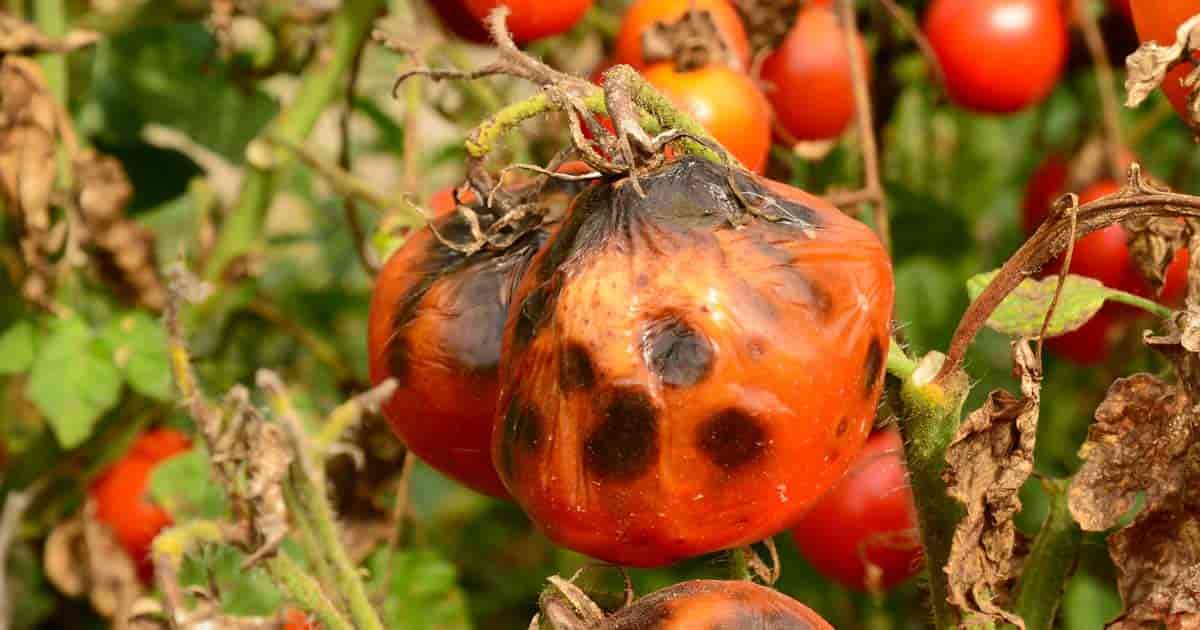In Latin, Phytophthora means plant destroyer. There are many different types of Phytophthora disease species. Each phytophthora species specializes in destroying specific types of plants.
Some of these plant diseases thrive in warm climates and others thrive in cool climates. For the most part, this organism is most active in the spring and in the autumn when the weather is rainy.

The organism was once classified as a fungus. Today we know it is actually an oomycete.
This is a life form that is a very fungus-like organism but is a closer relative of algae.
While this may not seem like much of a difference, this knowledge makes it easier to understand how to control this garden plague.
In this article, we explain what Phytophthora is and share advice on keeping it under control in your yard and garden. Read on to learn more.
Phytophthora Disease Damage
The damage of Phytophthora root rot is the most often discussed. The plant pathogen lurks in the soil or in debris on the soil and infects plants at the ground level.
All plant parts from crown rot, damping-off, collar rot, root diseases, late blight, stem rot, and more.
The different symptoms of Phytophthora infection are quite pervasive. The organism causes plants to weaken, collapse and die.
Some early warning signs mostly consist of symptoms of drought stress even when your plants are adequately watered and soil moisture is good.
Infected plants may wilt repeatedly and die of thirst the first time warm weather comes after they are infected.
Some may struggle for a number of years before finally dying off.
The leaves of Infected plants’ may be dull, fade and become discolored.
When you see color change out of season, it is a dead giveaway that something is very wrong.
How To Control Phytophthora Plant Diseases
Prevention is the best way to keep the many species of Phytophthora under control.
Be sure to plant new shrubs and trees in slightly elevated areas with soil amended to provide good drainage.
This is especially true of plants such as azaleas. Their roots must remain dry for the majority of hours in the day.
If Phytophthora is given four hours straight of standing water, it will germinate.
Once this happens, you’ll have a very difficult time battling the disease symptoms.
One technique many gardeners use is to plant all landscaping on mounds at least 8″ inches high. 10″ inches is better.
Furthermore, any time you plant any shrub, bush or tree, be careful to place it at exactly the same depth as it was in the pot or at the nursery.
You can tell where to place the soil by looking for a dark line on the plant’s trunk.
Once it takes hold, Phytophthora is very aggressive and it can cause a great deal of damage in your yard and garden as well as in large agricultural concerns.
Infected host plants cannot absorb water and nutrients because the organism kills off root tissue.
Sometimes, you can save infected plant material by removing and replacing the upper layer of soil.
With trees, remove it all the way to the surface of the main roots.
Examine those roots for discolored bark that is dark and oozing.
Cut away this damaged bark, and let the root system dry completely before replacing the soil with fresh soil.
Good Garden Hygiene Keeps Phytophthora At Bay
Use fungicides preventatively to help avoid the establishment of Phytophthora and other mold like organisms.
Don’t rely on this, though. Good garden maintenance habits are also necessary to help prevent this disease.
Follow these tips:
1. Water your yard garden and landscape evenly and avoid allowing plants to stand in water or remain wet for lengthy periods of time.
2. If you have an automatic irrigation system, be sure to set it up in a way that facilitates the movement of run-off water away from plant roots.
3. When plants become infected with Phytophthora, the most effective way to deal with it is to simply uproot them, contain them in sealed plastic bags and get rid of them.
4. After removing infected plants, dig up the soil in the surrounding area, use chemical control and treat it with fungicide and amend it in a way that helps improve drainage.
5. plant crops that are resistant to Phytophthora in areas where the organism has made its presence known.
6. When planting, be sure to leave plenty of space for good ventilation above the soil. Build up the soil to improve poor drainage by amending with gravel, coarse sand and other light organic materials to provide excellent drainage.
Make The Most Of Your Established Landscaping
Don’t be in a big hurry to replace old landscaping with new.
Phytophthora typically attacks younger trees. Older, more established trees are protected because they have a widely spreading root system.
This gives them lots of options for up taking nutrition and water.
Some sections may be damaged, but older, well-established trees have means in place to compensate for this damage.
Smaller plants like young bushes, shrubs, trees and also vegetables and ornamental plants do not have this protection.
If Phytophthora gets a foothold, the plant may be dead before you are even aware of the problem.